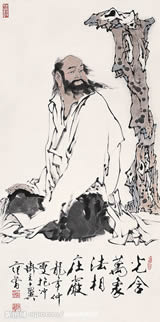DaMo & DaMo Qigong Practice

The General
Bodhidharma, transliterated as Pu Ti Da Mo or simply DaMo in China and known as Daruma Daishi in Japan, was an Enlightened Buddhist Master who is credited with bringing Zen Buddhism and reviving Buddhism in China and founding Shaolin martial arts.
Bodhidharma began his life as a royal prince in the Sardilli family in 482 A.D. in Southern India Kanchi, the capital of the Southern Indian kingdom of Pallava. He was a Brahman by birth, the third child of King Sugandha, was a member of the Kshatriya or warrior caste, and had his childhood in Conjeeveram (also Kanchipuram or Kancheepuram), a Buddhist province south of Madras. In the midst of his education and training to continue in his father’s footsteps as king, Bodhidharma chanced to receive the Buddha’s teachings. He immediately got the truth in Lord Buddha’s words and decided to give up his esteemed position and inheritance to study with the famous Buddhist teacher Prajnatara. Bodhidharma rapidly progressed in his Buddhist learning, and in time, Prajnatara sent Bodhidharma to China, where Buddhism had begun to perish, to introduce the Sarvastivada sect Buddhist teachings to the Chinese. Bodhidharma arrived in China after a brutal trek over Tibet’s Himalayan Mountains surviving both the extreme elements and treacherous bandits.
Upon arrival in China, the Emperor Wu Di, a devout Buddhist himself, requested an audience with Bodhidharma (in 520 A.D.). During their initial meeting, Wu Di asked Bodhidharma what merit he had achieved for all of his good deeds for building numerous temples and endowing monasteries throughout his empowered territorry.
Bodhidharma replied, “None at all.”
Perplexed, the Emperor then asked, “Well, what is the fundamental teaching of Buddhism?”
“Vast emptiness,” was the bewildering reply.
“Listen,” said the Emperor, now losing all patience, “just who do you think you are?”
“I have no idea,” Bodhidharma replied.
With this, Bodhidharma was banished from the Court,
Bodhidharma then set out for Luoyang, crossed the torrential Tse River (Chi Shui in Chinese) just upon one piece of reed leaf (This is the famous legendary story in China) and climbed Bear’s Ear Mountain in the Song Mountain range where the Shaolin Temple was located. But there the monks refused his admission. Bodhidharma then sat meditating in a small cave for the next 9 years facing the rock wall that’s about a mile from the Shaolin Temple, supposedly burning holes into the wall by staring at it and thus leaving a shadow upon the rock wall (In Damo Cave visitors can behold such sight). Only then did the monks of the Shaolin Temple respect Bodhidharma and allow him inside.
Bodhidharma, in true Mahayana spirit, was moved to pity when he saw the terrible physical condition that most monks were so out of shape from a life of study spent copying scrolls and
practiced long-term meditation retreats, which made them spiritually strong but physically weak. Their meditation method caused sleepiness among the monks. Remembering the experience of young Shakyamuni, who almost died from practicing asceticism, he informed the monks that he would teach them one set of practicing forms and approach originated from Buddha’s dharma incorporating a two-part program of meditation and physical training.
 Bodhidharma created an exercise program for the monks which involved physical techniques that
Bodhidharma created an exercise program for the monks which involved physical techniques that  were efficient in strengthening the body, and eventually, could be used practically in self-defense. When Bodhidharma instituted these practices, his primary concern was to make the monks physically strong enough to withstand both their isolated lifestyle and to demand training that meditation requires. It turned out that the techniques served a dual purpose as a very efficient fighting system, which evolved into a marital arts style called Shaolin Kung Fu. Martial arts training helped the monks to defend themselves against invading warlords and bandits. Bodhidharma taught that martial arts should be used for self-defense, and never to hurt or injure others needlessly. In fact, it is one of the oldest Shaolin axioms that “one who engages in combat has already lost the battle.”
were efficient in strengthening the body, and eventually, could be used practically in self-defense. When Bodhidharma instituted these practices, his primary concern was to make the monks physically strong enough to withstand both their isolated lifestyle and to demand training that meditation requires. It turned out that the techniques served a dual purpose as a very efficient fighting system, which evolved into a marital arts style called Shaolin Kung Fu. Martial arts training helped the monks to defend themselves against invading warlords and bandits. Bodhidharma taught that martial arts should be used for self-defense, and never to hurt or injure others needlessly. In fact, it is one of the oldest Shaolin axioms that “one who engages in combat has already lost the battle.”
Bodhidharma, a member of the Indian Kshatriya warrior class and a master of staff fighting, developed a system of 18 dynamic tension exercises. These movements found their way into print in 550 A.D. as the Yi Gin Ching, or Changing Tendon and Washing Marrow Classic. We know part of the system today as the Lohan (Priest-Scholar) 18 Hand Movements, the basis of Chinese Temple Boxing and the Shaolin Arts.
In fact, Tendon here means meridians in Acupuncture theory, and here generally it indicates twelve regular meridians and eight special meridians. Marrow means heart here. In fact, Acupuncture theory originated from Tao-pursuing practice and meridians play the key role for human’s corporeal existence which has been verified in the West. Changing meridians, in fact, implies to open up all channels throughout the body and get rid off all impedance in them. When such aim achieved, Qi can arise naturally to play its deserved role and gradually change the corporeal body in every aspect. When all channels are opened up and Qi arises in abundance and circulates fluently without any hindrance patients can own the power to first resist the invasion of diseases and later such two countering forces can reach a balance. Yet, if patients can persist in the cause without any intermission the time will come that their internal defense power can overwhelm any existence of diseases. As a result, people can gain the long-standing health well being physically.
Yet, when the heart always pursues the things outside and never one instant of stillness settles in, the desires and passion will never spare one instant to run in to pollute the bowels and viscera through heart. Under such circumstances, who can guarantee the eternally being free of any diseases. Therefore, changing Tendon we can strengthen the corporeal existence of our bodies physically from outside, while washing marrow we can achieve the infinite stillness and emptiness mentally and internally. To pursue the cause without break, who can say we cannot gain the eternity?
That is the origin of DaMo Qigong and nowadays, DaMo Qigong incorporates more new things after long-term development and evolution. It is a whole set of system which can meet majority people’s practical needs which include curing chronic diseases, gaining health well being, searching for a piece of spiritual land, achieving Tao and nirvana.
Yet, most people would rather to get the meaning directly from the words themselves, and as a result, the superficial meaning often prevails for long in history. People know there are endless Buddhism scriptures and books which can pile up to form a skyscraper. And the contents so enormously concerns the good deeds, retrospective originations, causes and results, kindness and mercy, far-reaching promises for all human beings, and infinite power and might, etc. But as the practical meditation means as concerned, just a few bits scattered in one part of book and other bits in another. Who ever gained the chance to review it in a systematic way. Here perhaps three books should be mentioned for their importance in this regard. One is Jin Gang Sutra, the other two are Secret Sutra and The Heart Sutra. They together present the systematic phases necessary for cultivating the heart and the most important, they display the theory and methods in a more clear and simple way.
Yet, only in combination of Changing Tendon and Washing Marrow Classic, the three scriptures can be told to be perfect in expressing Buddha’s idea and offering practical approaches in the same time.
The legend states that Bodhidharma settled in the Shaolin Temple of Songshan in Hunan Province in 526 A.D. “The First Buddha”, by the order of Emperor Wei on the Shao Shik Peak of Sonn Mountain in Teng Fon Hsien, Hunan Province. The Temple was for religious training and meditation only. Martial arts training did not begin until the arrival of Bodhidharma in 526 A.D. Bodhidharma died in 539 A.D. at the Shaolin Temple at age 57.
During his life he had very few disciples, only three of which have made it into the history books. Bodhidharma transmitted the patriarchship of his lineage to Hui-k’o. A few years after his death, a Chinese official reported encountering Bodhidharma in the mountains of Central Asia. Bodhidharma was reportedly carrying a staff from which hung a single sandal, and he told the official that he was on his way back to India. When this story reached his home, his fellow monks decided to open Bodhidharma’s tomb. Inside there was nothing but a sandal. In fact, in Chinese alchemy theory, such skill is common and nothing special. Yet for general people, it is impossible. Why? People only know existence and never know nonexistence. Only both of them can constitute an entity in combination, with one the part forming exterior and another interior.
According to Tao-husan’s Futher Lives of Exemplary Monks (the first draft of which was written in 645), the sermons published in The Zen Teaching of Bodhidharma were delivered by Bodhidharma himself. However in The Zen Teaching of Bodhidharma, the author says:
“ The only reason I’ve come to China is to transmit the instantaneous teaching of the Mahayana: This mind is the Buddha. I don’t talk about precepts, devotions or ascetic practices such as immersing yourself in water and fire, treading a wheel of knives, eating one meal a day, or never lying down. These are fanatical, provisional teachings. Once you recognize your impermanence, miraculously aware of nature, yours is the mind of all Buddhas. ”
Bodhidharma was an extraordinary being who remains an example and an inspiration to practitioners today. He is the source of many miraculous stories of ferocity and dedication to the Tao. One such legend states that Bodhidharma became frustrated once while meditating because he had fallen asleep. He was so upset that he cut off his eyelids to prevent this interruption in meditation from ever happening again. Yet another legend states that Bodhidharma meditated for so long that his arms and legs eventually fell off. This is a reminder of the true dedication and devotion necessary in meditation practice.
OPENING HOURS
| Week Days | 8:00 – 5:00 |
| Saturday | 9:00 – 5:00 |
| Sunday | 11:00 – 4:00 |




